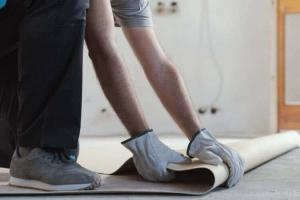Step-by-Step Guide to Installing Linoleum Flooring for Your Home

-
Quick Links:
- Introduction
- What is Linoleum?
- Advantages of Linoleum Flooring
- Preparing for Installation
- Tools and Materials Needed
- Installation Process
- Case Studies
- Expert Insights
- Maintenance and Care
- FAQs
Introduction
Installing linoleum flooring is a rewarding DIY project that can enhance the aesthetic and functional value of your home. This guide aims to provide a comprehensive overview of how to install linoleum flooring, including preparation, installation steps, and tips for maintenance.
What is Linoleum?
Linoleum is a resilient flooring material made from natural materials like linseed oil, cork dust, wood flour, and jute. Known for its durability and eco-friendliness, linoleum comes in a variety of colors and patterns, making it a popular choice for homes.
Advantages of Linoleum Flooring
- Durability: Can last up to 40 years with proper care.
- Eco-Friendly: Made from natural, renewable materials.
- Variety of Designs: Available in numerous colors and patterns.
- Low Maintenance: Easy to clean and maintain.
- Comfort: Provides a softer underfoot compared to tile or hardwood.
Preparing for Installation
Before starting your installation, there are several important steps to take to ensure success:
- Choose the Right Linoleum: Select a style that complements your home.
- Measure Your Space: Calculate the square footage of the area you plan to cover.
- Acclimate the Material: Allow the linoleum to acclimate to your home’s temperature for at least 48 hours.
Tools and Materials Needed
Tools
- Utility knife
- Square
- Measuring tape
- Floor roller
- Adhesive
- Notched trowel
- Seam roller
Materials
- Linoleum sheets or tiles
- Adhesive (specific to linoleum)
- Underlayment (if necessary)
- Sealer (optional)
Installation Process
Step 1: Prepare the Subfloor
Ensure the subfloor is clean, dry, and level. Remove any old flooring and repair cracks.
Step 2: Cut the Linoleum
Using a utility knife, cut the linoleum to fit your room dimensions, allowing for about 1 inch over each edge.
Step 3: Apply Adhesive
Using a notched trowel, apply the adhesive to the subfloor, following the manufacturer’s instructions for drying time.
Step 4: Lay the Linoleum
Carefully lay the linoleum onto the adhesive, starting from one corner and working your way across the room.
Step 5: Roll and Seal
Use a floor roller to ensure proper adhesion and remove air bubbles. If desired, seal the seams and edges with a seam roller.
Step 6: Allow to Cure
Let the linoleum cure for at least 24 hours before walking on it or placing furniture.
Case Studies
Here are a couple of case studies showcasing successful linoleum flooring installations:
Case Study 1: Family Kitchen Renovation
A family of four wanted a durable yet stylish flooring option for their kitchen. After researching various materials, they opted for a patterned linoleum that complemented their cabinetry, resulting in a vibrant and functional space.
Case Study 2: Eco-Friendly Office Space
An office renovation was aimed at achieving sustainability. Linoleum flooring was chosen for its eco-friendly properties, reducing their carbon footprint while providing an attractive work environment.
Expert Insights
We spoke to several flooring experts, and here are some of their insights:
- “Linoleum is often overlooked in favor of vinyl, but it offers unique benefits that align with eco-conscious choices.” - Jane Doe, Flooring Expert.
- “Proper acclimation and subfloor preparation are key steps that can greatly affect the longevity of your installation.” - John Smith, Home Renovation Specialist.
Maintenance and Care
To keep your linoleum flooring looking its best, follow these maintenance tips:
- Regularly sweep or vacuum to remove dirt and debris.
- Use a damp mop with a mild detergent for deeper cleaning.
- Avoid harsh chemicals that can damage the surface.
FAQs
1. How long does linoleum flooring last?
With proper care, linoleum flooring can last up to 40 years.
2. Is linoleum flooring waterproof?
Linoleum is water-resistant but not completely waterproof. It is advisable to clean spills promptly.
3. Can I install linoleum over existing flooring?
It's best to install linoleum over a clean, level subfloor for optimal results.
4. Do I need underlayment for linoleum?
Underlayment is not always necessary but can provide additional cushioning and insulation.
5. How do I clean linoleum flooring?
Regular sweeping and damp mopping with mild detergent are recommended for maintenance.
6. Can linoleum be used in bathrooms?
Yes, linoleum can be used in bathrooms, but ensure proper sealing to prevent moisture damage.
7. Is linoleum flooring easy to install?
With the right tools and guidance, linoleum flooring can be a manageable DIY project.
8. What are the benefits of linoleum over vinyl?
Linoleum is made from natural materials, making it more eco-friendly and often more durable than vinyl.
9. Can I use a steam cleaner on linoleum?
No, steam cleaners can damage linoleum flooring. Stick to damp mopping instead.
10. What should I do if my linoleum flooring gets scratched?
Small scratches can often be buffed out with a soft cloth. For deeper scratches, consult a flooring professional.
Random Reads
- How to locate your sewer cleanout
- How to repair a blown speaker
- How to repair a computer
- How to hang painting
- What equalizer settings are best for bass
- How to make an international call to mexico
- How to register domain google
- How to register samsung smart tv
- Ultimate guide to troubleshooting washer not draining
- How to hear audio from remote pc